Traditional Techniques in Moroccan Pottery
CRAFTSMANSHIP & TECHNIQUES


Moroccan pottery is renowned for its beauty, craftsmanship, and cultural significance. Each piece is the result of meticulous, time-honored techniques that have been passed down through generations. These traditional methods—such as wheel-throwing, hand-painting, and glazing—are not only essential to the creation of pottery but also serve as a link to Morocco’s rich artisanal heritage. The process of making pottery in Morocco reflects the deep connection between artisans and their craft, combining skill, patience, and creativity to produce works that are both functional and artistic.
Wheel-Throwing: The Art of Shaping Clay
The ancient art of wheel-throwing sits at the heart of Moroccan pottery. This method, which dates back thousands of years, involves using a potter’s wheel to shape raw clay into various forms. The potter, seated at a traditional foot-powered or electric wheel, skillfully spins the clay while shaping it with their hands, using gentle pressure to mold the material into the desired shape.
Wheel-throwing is a skill that takes years to master, and in Morocco, it is often a family tradition. Artisans typically learn the craft from their parents or grandparents, beginning as apprentices at a young age. The process requires extreme precision, as the potter must control the speed of the wheel and the pressure of their hands to ensure that the clay forms evenly and smoothly.
In Moroccan workshops, artisans create a wide variety of pottery items using this technique, from large cooking pots and jugs to intricate bowls and vases. Each piece is unique, reflecting the potter’s individual touch and the specific requirements of the item being made.
Hand-Painting: preserving Morocco's cultural motifs
Moroccan artisans often hand-paint Moroccan pottery with vibrant, intricate designs that reflect the country's artistic traditions after shaping and firing the clay. Hand-painting is one of the most distinctive aspects of Moroccan pottery, and it is where artisans truly showcase their creativity and mastery of design.
Using fine brushes, potters carefully apply patterns that range from geometric shapes and floral motifs to elaborate arabesque designs inspired by Islamic art. These patterns are often symbolic, carrying deep cultural and spiritual meanings. Geometric designs, for instance, represent the infinite nature of creation, while floral motifs celebrate the universe and beauty. The precision required in hand painting is immense, as artisans must work on uneven surfaces with steady hands and an eye for detail.
The colors used in Moroccan pottery are often bold and striking, with cobalt blue, green, yellow, and red being the most common hues. Natural pigments provide these colors, upholding the craft's tradition of using organic materials. Each region in Morocco has its distinct style of pottery decoration, with cities like Fez and Safi being particularly famous for their unique patterns and color palettes.
Glazing: The Final Touch
Glazing is the final stage in the pottery-making process, which not only enhances the pottery's beauty but also serves to protect it. Applying a glass-like coating to the pottery surface and firing it in a kiln results in a smooth, glossy finish. The glaze seals the surface of the pottery, making it watertight and durable.
Moroccan potters traditionally use lead-free, natural glazes, often made from minerals and metallic oxides. The deep blue glaze is the most famous in Moroccan pottery, particularly in the city of Safi. Other common glazes include vibrant greens, yellows, and whites, which give Moroccan ceramics their signature appearance.
The glazing process is delicate and requires a deep understanding of both materials and temperature. An uneven glaze application or an overheated kiln can cause the finish to crack or bubble. Moroccan artisans rely on generations of knowledge and experience to ensure that each piece emerges from the kiln with a flawless, glossy sheen.
4. Hand-Building: Creating Unique Shapes
While wheel-throwing is the most common technique for shaping pottery, Moroccan artisans also use hand-building methods, particularly for creating larger or more complex pieces. Hand-building involves shaping the clay by hand, often using coils or slabs of clay to build the structure piece by piece. This method enables artisans to create intricate, one-of-a-kind works that are impossible to make on a wheel, allowing for greater design flexibility.
Hand-building is especially important in the creation of architectural ceramics, such as large decorative plates, urns, and tiles. It is a slow, labor-intensive process, but it allows artisans to push the boundaries of their craft, creating stunning, large-scale pieces that showcase the depth of their skill and creativity.
5. The Transmission of Tradition: Pottery as Cultural Heritage
The beauty of the finished products and the generations-long transmission of these traditional techniques are what truly distinguish Moroccan pottery. Pottery is more than a craft in Morocco—it is a way of life for many families, particularly in rural areas where pottery production remains a vital economic activity. Entire communities are often involved in the process, from gathering clay to firing the final pieces in communal kilns.
Moroccan culture deeply roots the transmission of these techniques, with many artisans beginning their training as children. The craft thrives in the modern world thanks to the transmission of knowledge from one generation to the next. Today, despite the pressures of industrialization and globalization, Moroccan pottery remains a symbol of the country’s artistic heritage. Using the same methods used for centuries, artisans continued to create pottery by hand.
Conclusion
Traditional techniques in Moroccan pottery, such as wheel-throwing, hand-painting, glazing, and hand-building, are a testament to the skill and dedication of Morocco’s artisans. These handcrafted methods passed down through generations, not only preserve the country’s rich cultural heritage but also produce some of the most beautiful and unique ceramics in the world. Each piece of Moroccan pottery is a work of art, reflecting the mastery of the potter and the deep cultural significance of the craft. By continuing to uphold these traditions, Moroccan artisans ensure that their pottery remains a vibrant and cherished part of both Moroccan culture and global artisanal heritage.
